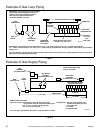
© Copyright, Alliance Laundry Systems LLC – DO NOT COPY or TRANSMIT
20 M414545
FACILITIES REQUIRED
To assure compliance, consult local building code
requirements.
FLOOR
The tumbler must be installed on a level floor capable of
supporting 100 pounds per square foot (488.3 kg/sq. m).
Floor covering materials such as carpeting or tile must be
removed.
LAYOUT
Whenever possible, tumblers should be installed along an
outside wall where duct length can be kept to a minimum,
and make-up air can be easily accessed. Construction
must not block the airflow at the top rear of the tumbler.
Doing so would prevent adequate air supply to the
tumbler’s combustion chamber.
VENTING
For maximum efficiency and minimum lint
accumulation, tumbler air must be exhausted to the
outdoors by the shortest possible route.
Proper sized exhaust ducts are essential for proper
operation. All elbows should be sweep type. Exhaust
ducts must be assembled so the interior surfaces are
smooth, so the joints do not permit the accumulation of
lint. Do not use sheet metal screws to join vent sections.
Improperly sized or assembled ductwork causes excess
back pressure which results in slow drying, lint collecting
in the duct, lint blowing back into the room, and
increased fire hazard.
Exhaust ducts shall be constructed of sheet metal or
other noncombustible material. Such ducts must be
equivalent in strength and corrosion resistance to
ducts made of galvanized sheet steel not less than
0.0195 inches (0.495 mm) thick.
Where the exhaust duct pierces a combustible wall or
ceiling, an opening having a diameter of 4 inches (10.2
cm) larger than the diameter of the exhaust duct shall be
provided, with the duct centered in the opening. When
ducts pass through walls, ceilings, floors or partitions, the
space around the duct shall be sealed with non-
combustible material. Refer to Figures 3, 4 and 5.
• Individual Venting
For maximum efficiency and performance, it is
preferred to exhaust tumbler(s) individually to the
outdoors. At no point may the cross area of installed
venting be less than the cross area of the exhaust
thimble of the tumbler.
The maximum allowable length venting is 14 feet (4.3
m) and two 90° elbows or equivalent. If the equivalent
length of a duct required for an installation exceeds the
maximum allowable equivalent length, the diameter of
a round duct must be increased by 10% for each
additional 20 feet (6.1 m). Cross section area of a
rectangular duct must be increased by 20% for each
addtional 20 feet (6.1 m). To determine equivalent
venting, Refer to Table 1.
Table 1
Example: A 12" diameter duct’s equivalent
length of 14 feet of duct and two 90° elbows is:
Equivalent Length = 14 feet + (2) 90° elbows
= 14 feet + 14 feet + 14 feet
= 42 feet (12.8 m)
With the tumbler in operation, airflow at any point in
the duct must be at least 1200 feet per minute (366 m./
min.) to insure that the lint remains airborne.
A drying tumbler produces combustible
lint. To reduce the risk of fire, the tumbler
must be exhausted to the outdoors.
W057
WARNING
DUCT
DIAMETER
EQUIVALENT LENGTH OF
STRAIGHT DUCT
6" (15.2 cm)
8" (20.3 cm)
10" (25.40 cm)
12" (30.48 cm)
14" (35.56 cm)
16" (40.64 cm)
18" (45.72 cm)
One 90° elbow = 7 feet (2.1 m)
One 90° elbow = 9.3 feet (2.83 m)
One 90° elbow = 11.6 feet (3.5 m)
One 90° elbow = 14 feet (4.3 m)
One 90° elbow = 16 feet (4.9 m)
One 90° elbow = 18.7 feet (5.7 m)
One 90° elbow = 21 feet (6.4 m)
Equivalent Length (feet) = 1.7 x Duct Diameter
(inches)


















